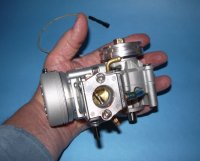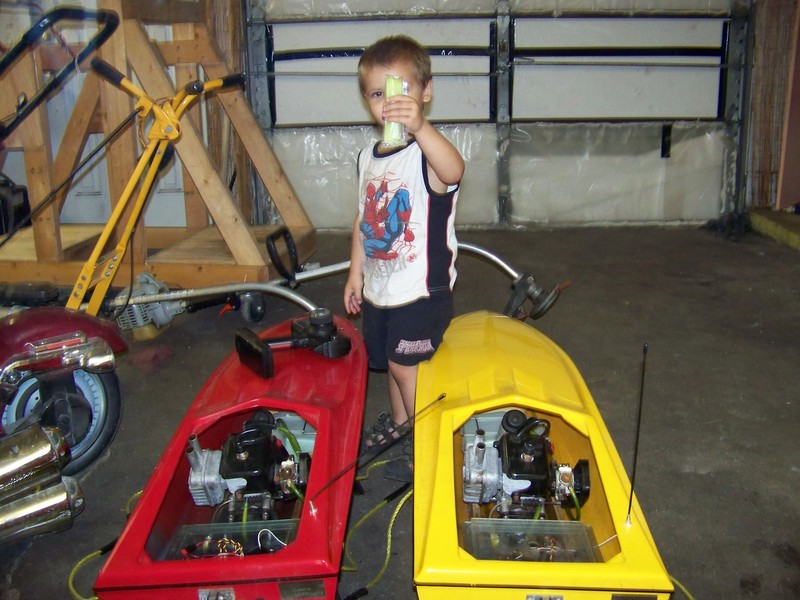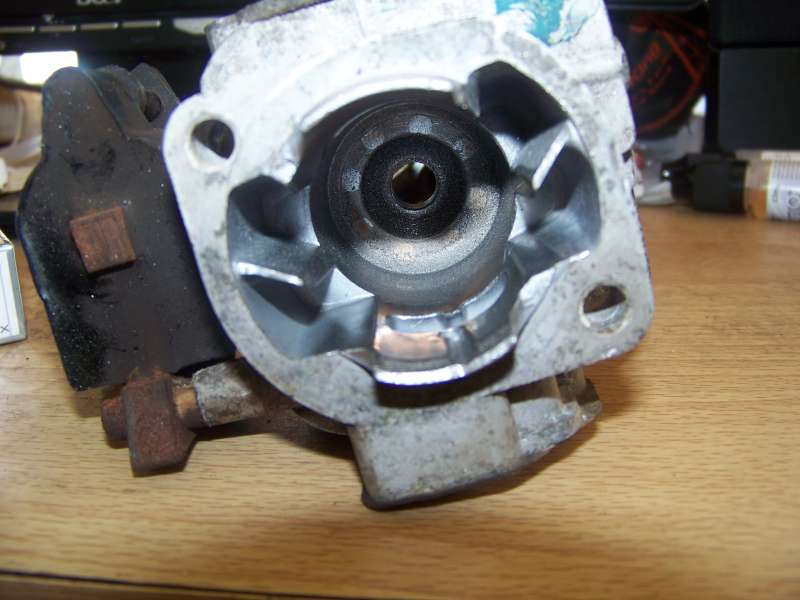Transfer bridge
noworknguy created the topic: Transfer bridge
I see that some engine builders cut the transfer bridge and some don't. Why is the T/B cut? Thank you .
Please Log in or Create an account to join the conversation.
- noworknguy
- Offline
- Posts: 48
- Karma: 1
- Thank you received: 2
Hot Rods replied the topic: Transfer bridge
Some eng. modders ( very few ) cut down the bridges for more transfer volume. But when you actually look at the area that is gained, it amounts to very little. But what is being lost, is velocity and to a slightly lesser extent, directional stability into the cyld. The way the transfers direct and aim the flow is crutial to developing the best power at high RPM. If the directed flow has much less push ( velocity ) behind it, the intended aiming can be lazy. We try very hard to get our tuned pipes to pull on the transfers as hard as they can during scavenging, why would we want to slow the flow just before it enters the cyld? The primary and secondary transfer ports ( that the bridges separate ) are not aimed the same. We need the flow to come out of the case, up the transfers as quickly and smoothly as we can. Keeping the flow smooth and aimed toward the two ( 4 ) different transfer windows by way of full length bridges, assures we are getting the most out of our pipes. As I see it, a perfect example of poor design is the TK cyld. It has huge transfers coming out of the case, and very short bridges just before the windows. The exh. exit is poor in my opinion as well, but that's not the question. Extensive, reliable dyno testing has shown the full length bridges out perform the cut downs, in the RPM range we run.
The following user(s) said Thank You: noworknguy, Gulf Coast
Please Log in or Create an account to join the conversation.
- Hot Rods
-

- Offline
- Posts: 164
- Karma: -5
- Thank you received: 36
Please Log in or Create an account to join the conversation.
- noworknguy
- Offline
- Posts: 48
- Karma: 1
- Thank you received: 2
CC Racing Engines replied the topic: Transfer bridge
Guys,
Dennis was spot on with his answer for this one. Cutting that divider down is a big no in my book. In my opinion that is one of the main reasons the RCMK cylinders do not make as much power as the Zenoah cylinders they have tried to copy. That Bridge/Divider/Director is too far down in the transfers and being that short and abrupt causes a major disturbance in air flow in a area that is already a trouble zone. A longer smoother transition in this case will always be better. That divider has more jobs then one and is responsible for piston and ring support as well as being a airflow director. It is a shame that these new companies coming on the market have know one with any idea of how things actually work guiding them along.
Carlo
Dennis was spot on with his answer for this one. Cutting that divider down is a big no in my book. In my opinion that is one of the main reasons the RCMK cylinders do not make as much power as the Zenoah cylinders they have tried to copy. That Bridge/Divider/Director is too far down in the transfers and being that short and abrupt causes a major disturbance in air flow in a area that is already a trouble zone. A longer smoother transition in this case will always be better. That divider has more jobs then one and is responsible for piston and ring support as well as being a airflow director. It is a shame that these new companies coming on the market have know one with any idea of how things actually work guiding them along.
Carlo
www.rcbwc.com
Ego Means Nothing
Talent Means Something
Heart Means Everything
Don't believe what you hear
Believe what you see.
Carlo Catalanotto
www.ccracingengines.com
This email address is being protected from spambots. You need JavaScript enabled to view it.
1-504-304-5077
Last edit: 11 years 8 months ago by CC Racing Engines.
The following user(s) said Thank You: Gulf Coast
Please Log in or Create an account to join the conversation.
- CC Racing Engines
-

- Offline
- Vendor ...
- Posts: 149
- Thank you received: 23
Please Log in or Create an account to join the conversation.
- noworknguy
- Offline
- Posts: 48
- Karma: 1
- Thank you received: 2
Hot Rods replied the topic: Transfer bridge
Guys, Carlo is ALMOST spot on with his answer LOL. Just havin fun with ya LO; NO-ONE has more respect for you than I.
Carlo, I don't know if you're referring to the MKs that Scott modded for the porting article on this site some years back, because he shortened the bridges considerably. But all the MKs that I have built, have the bridges just slightly above the deck surface, only a few thou shorter than a Zen. The reason that some MKs don't make the power that Zens do, is because they are porting them just like a Zen, and because of costs and distribution, there is no incentive ( or money to be made ) to do the intensive development work that could show better results. There is a lot of meat in the MK cylds. that no-one has explored. By using the meat to advantage, it opens up the chance to change other parameters, to further the potential. And I don't mean just hog out everything larger.
Anyway, we all have our favorite poison, and Lo and I are on the same page most times; like with transfer bridges LOL.
Good question!
Carlo, I don't know if you're referring to the MKs that Scott modded for the porting article on this site some years back, because he shortened the bridges considerably. But all the MKs that I have built, have the bridges just slightly above the deck surface, only a few thou shorter than a Zen. The reason that some MKs don't make the power that Zens do, is because they are porting them just like a Zen, and because of costs and distribution, there is no incentive ( or money to be made ) to do the intensive development work that could show better results. There is a lot of meat in the MK cylds. that no-one has explored. By using the meat to advantage, it opens up the chance to change other parameters, to further the potential. And I don't mean just hog out everything larger.
Anyway, we all have our favorite poison, and Lo and I are on the same page most times; like with transfer bridges LOL.
Good question!
Please Log in or Create an account to join the conversation.
- Hot Rods
-

- Offline
- Posts: 164
- Karma: -5
- Thank you received: 36
Gulf Coast replied the topic: Transfer bridge
So basically leave the bridges alone and just make the ports smoother? for better forced flow?
Please Log in or Create an account to join the conversation.
- Gulf Coast
-

- Offline
- Posts: 70
- Thank you received: 0
Hot Rods replied the topic: Transfer bridge
What you can do with the bridges, is to sharpen the leading edge of the bridge to separate the flow paths a little easier. Anywhere in the case/transfers where there is mismatch of surfaces will cause disruption of flow. Anytime the flow is disrupted or turned suddenly, there is the potential of the heavier fuel/oil to separate from the much lighter air, and it could result in a less than great burn. "Wet flow" likes a certain degree of "texture" on the surfaces, to keep good atomization. So yes, the passages should be smooth, but not polished.
"Dry flow" ( exh. gases ) will move faster with a polished surface.
"Dry flow" ( exh. gases ) will move faster with a polished surface.
The following user(s) said Thank You: Gulf Coast
Please Log in or Create an account to join the conversation.
- Hot Rods
-

- Offline
- Posts: 164
- Karma: -5
- Thank you received: 36
Last edit: 11 years 8 months ago by Gulf Coast. Reason: none.
Please Log in or Create an account to join the conversation.
- Gulf Coast
-

- Offline
- Posts: 70
- Thank you received: 0
Time to create page: 0.106 seconds

